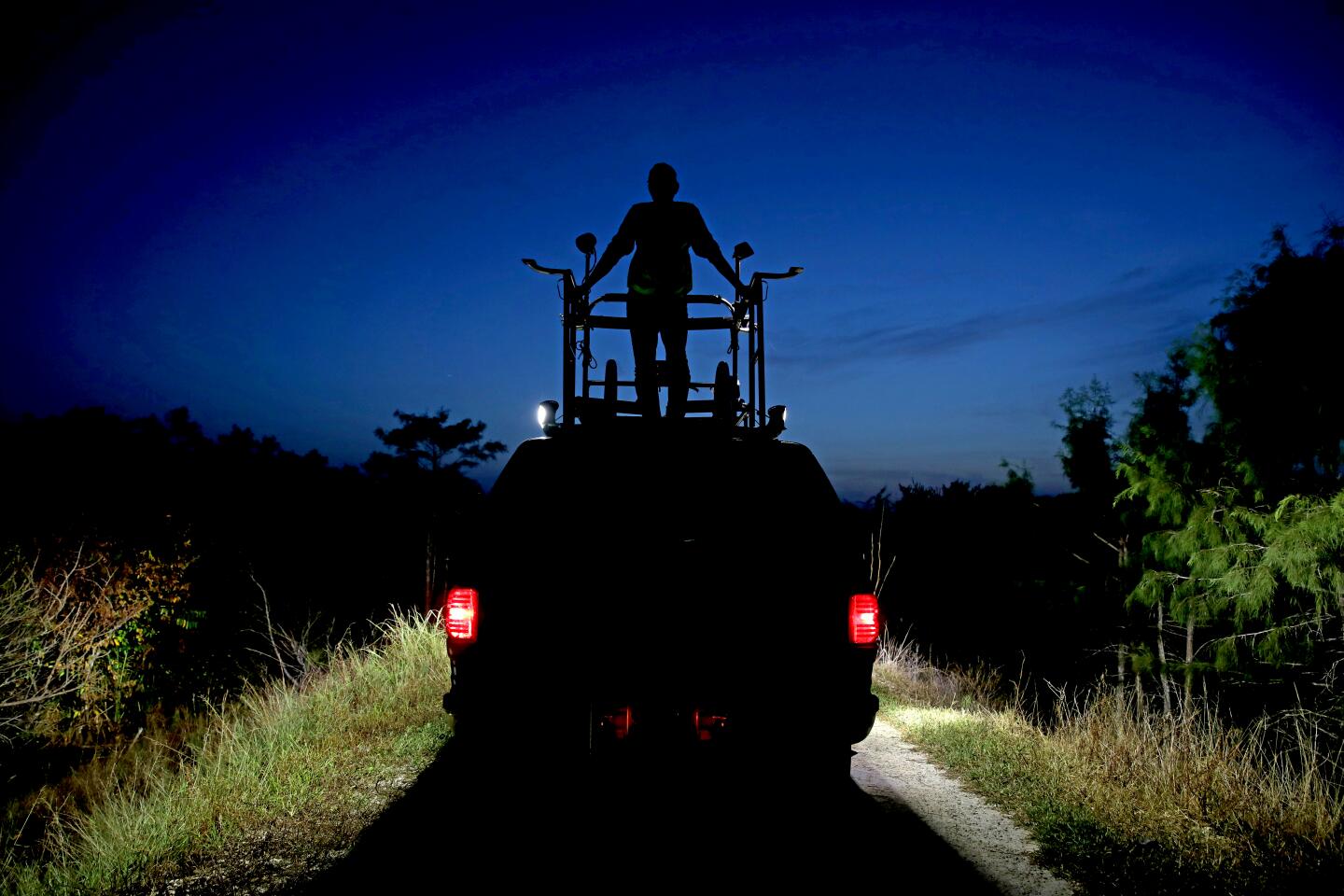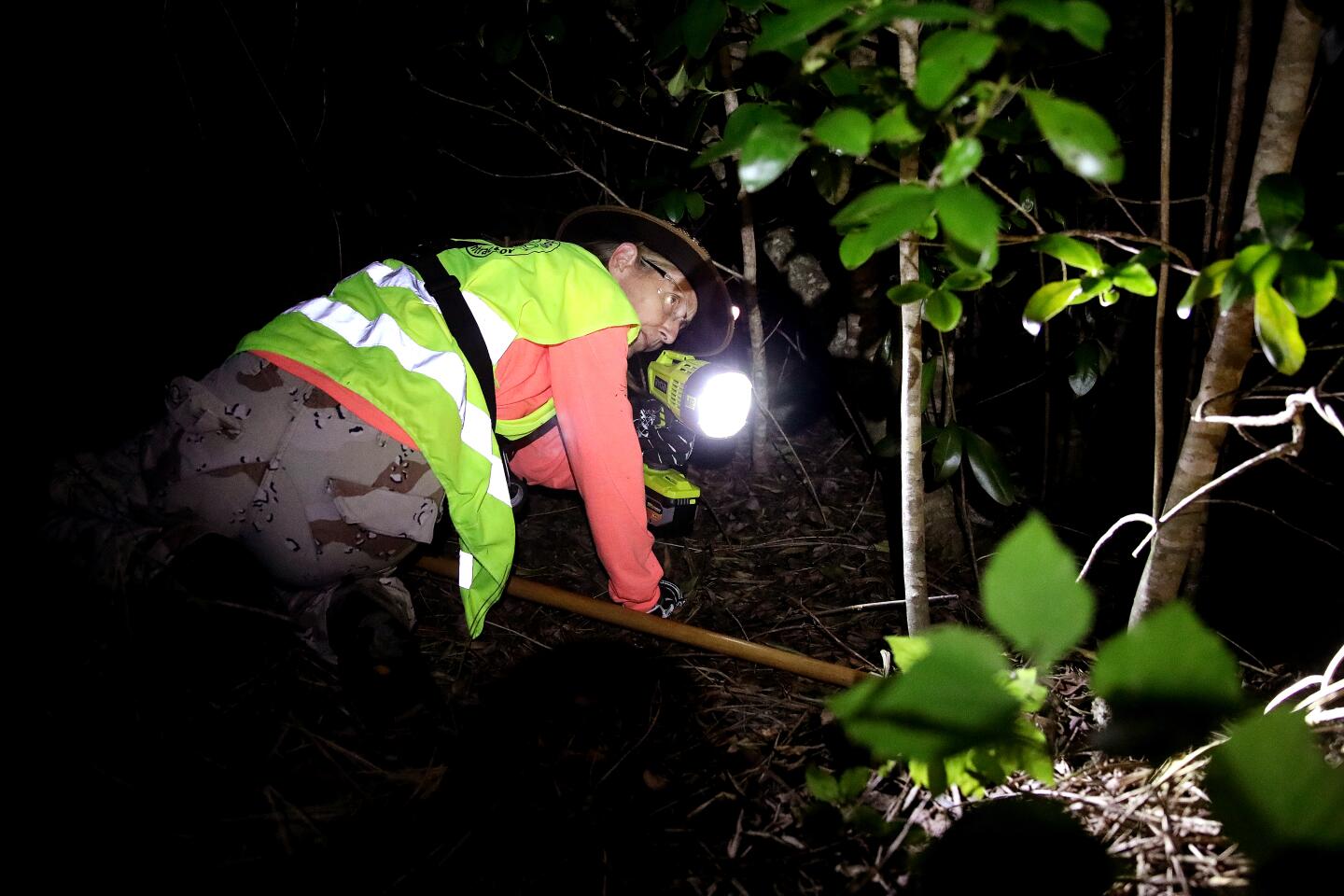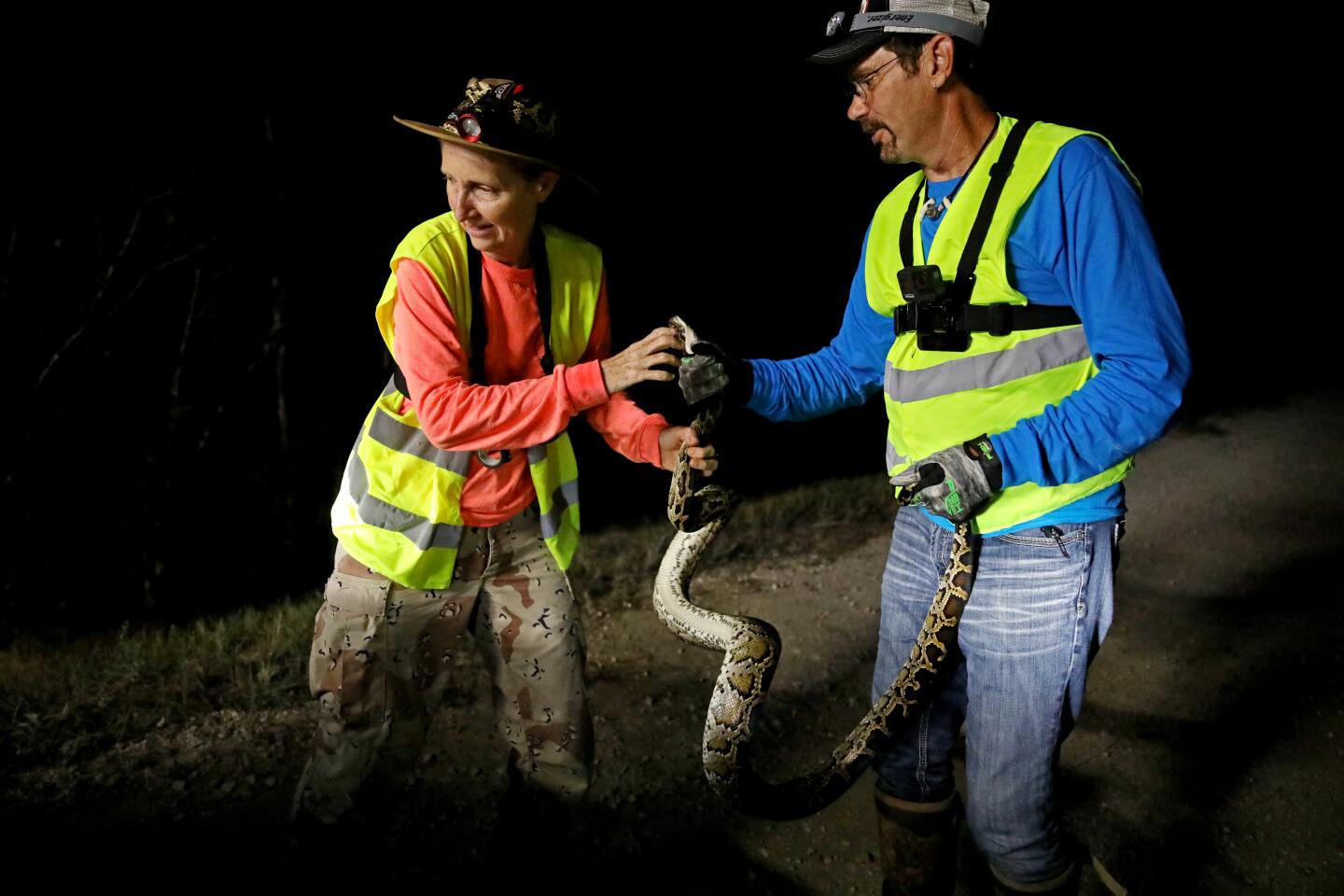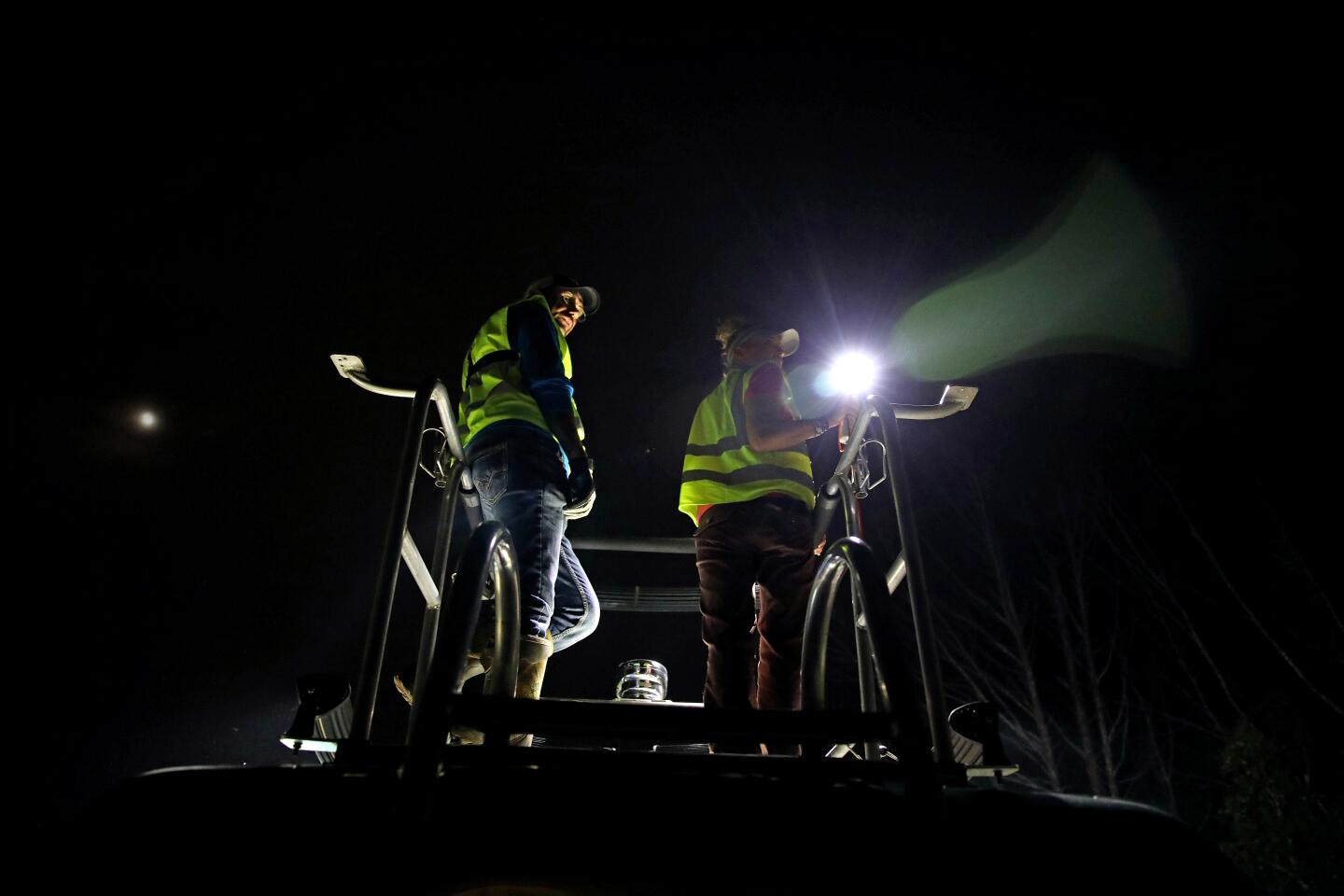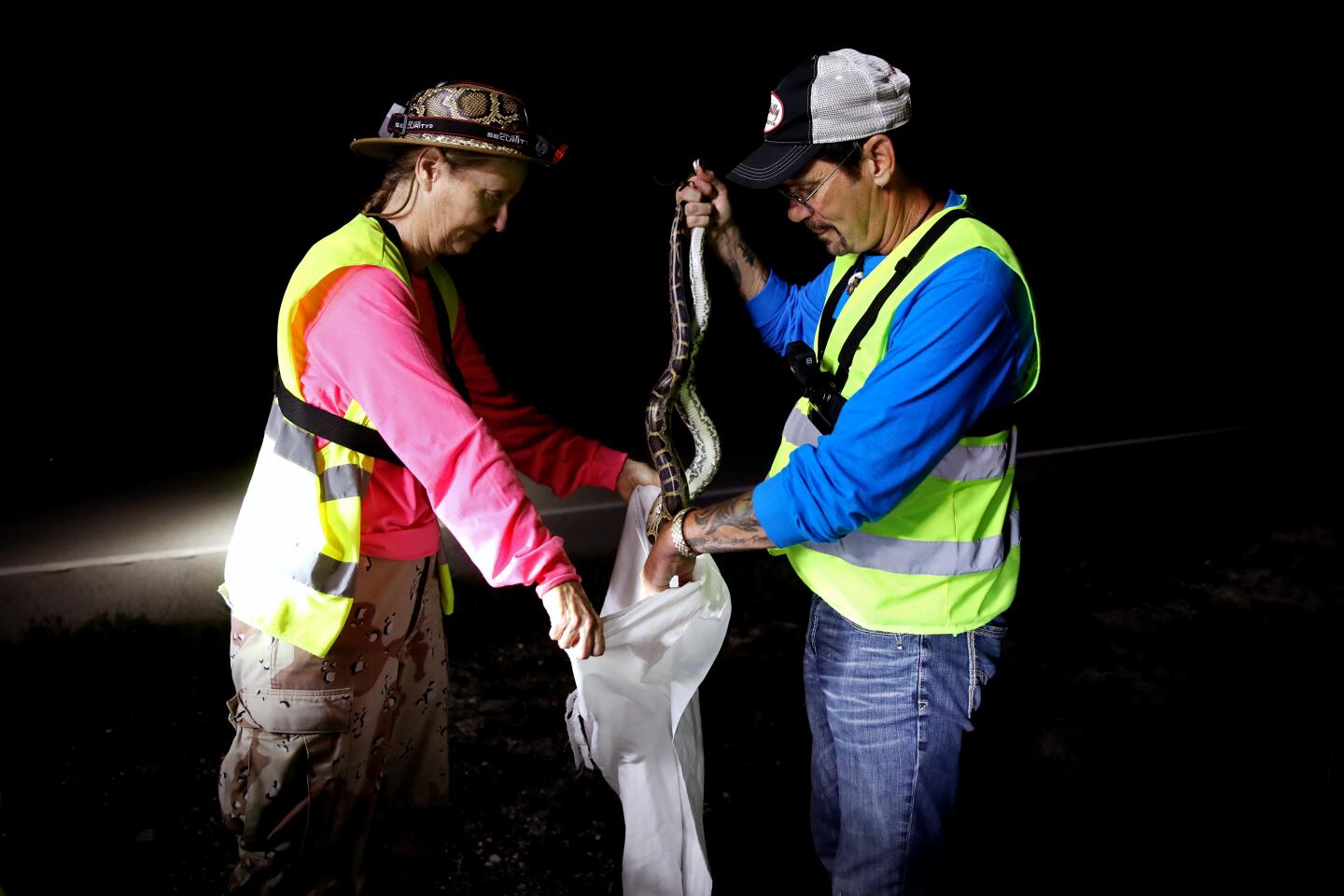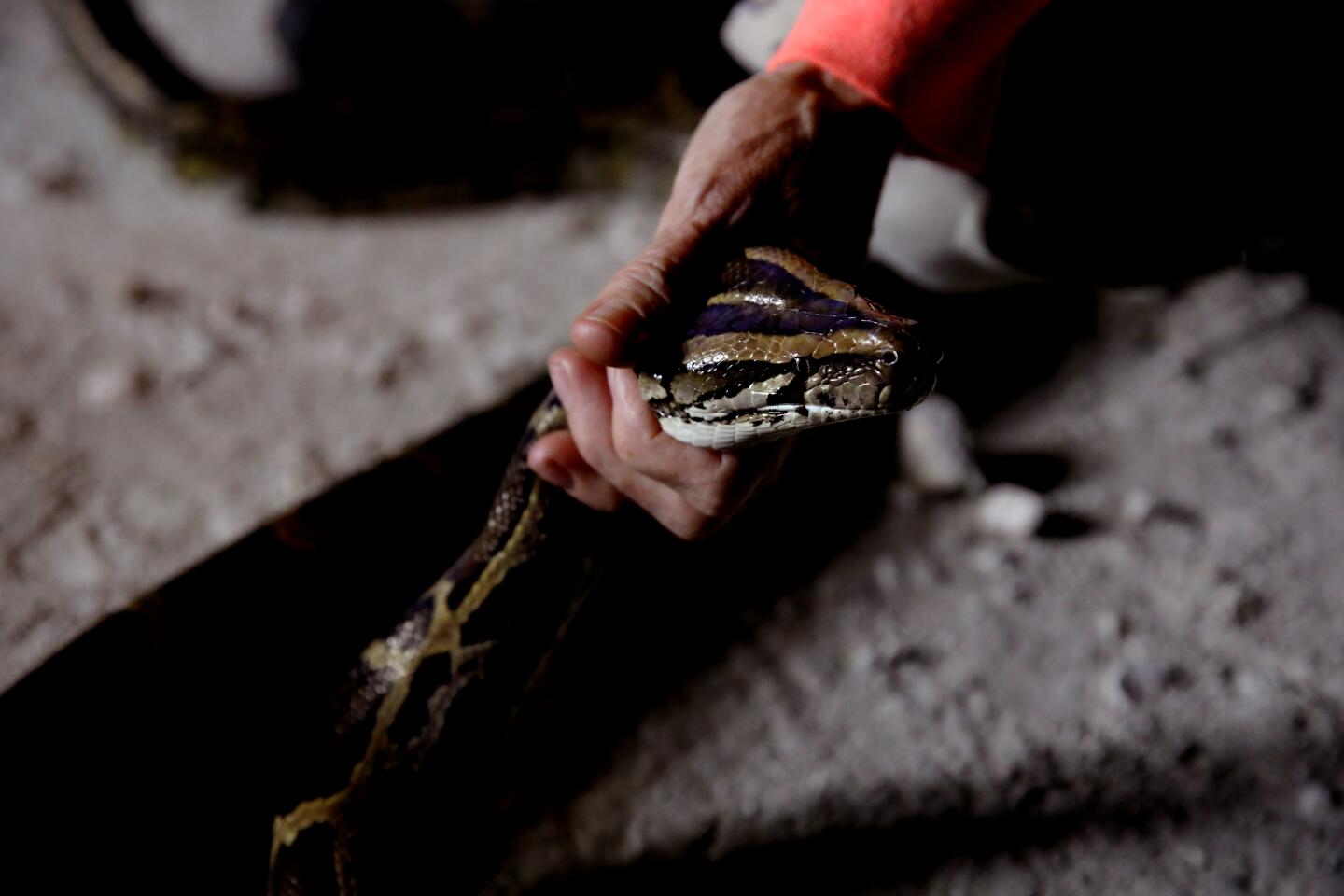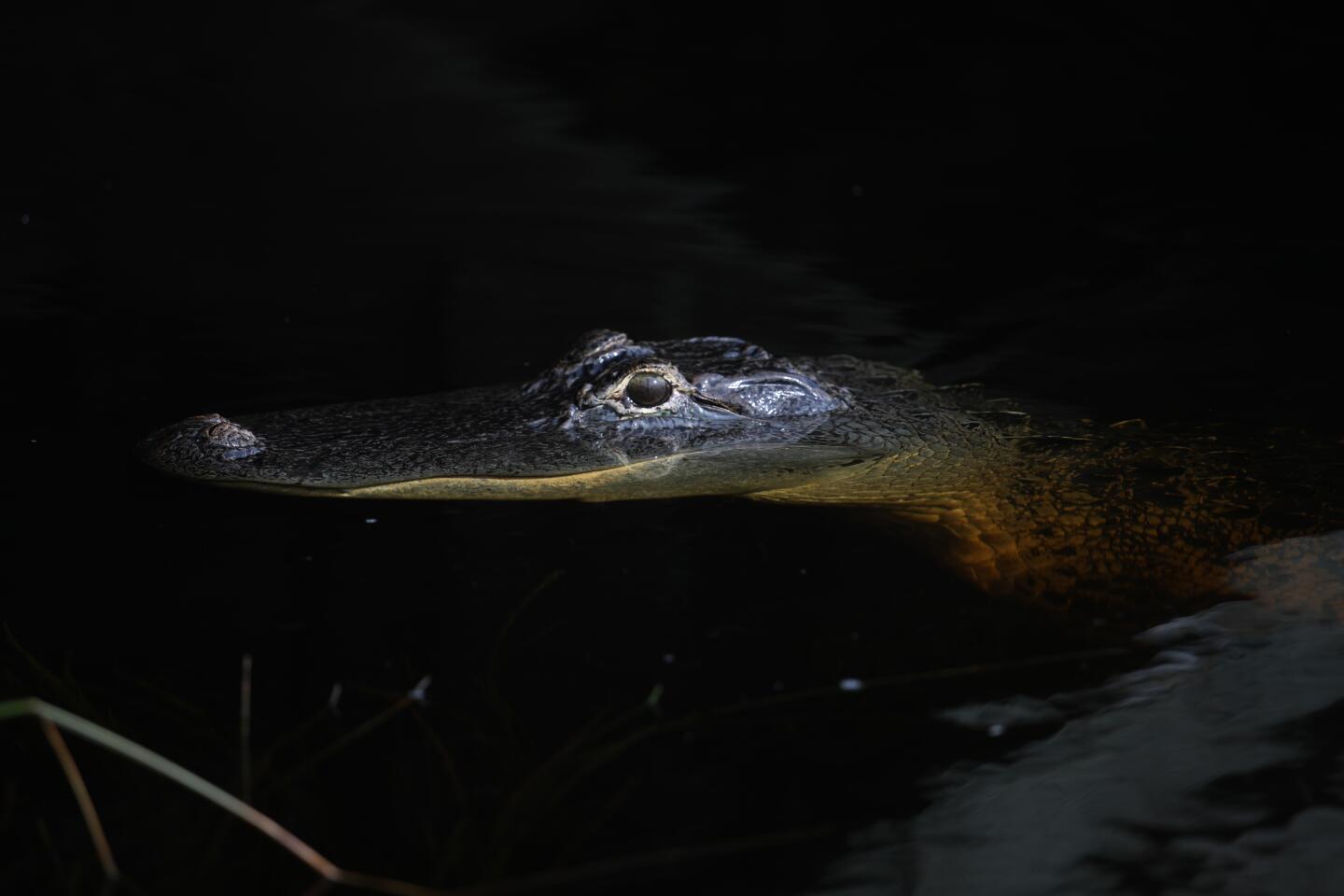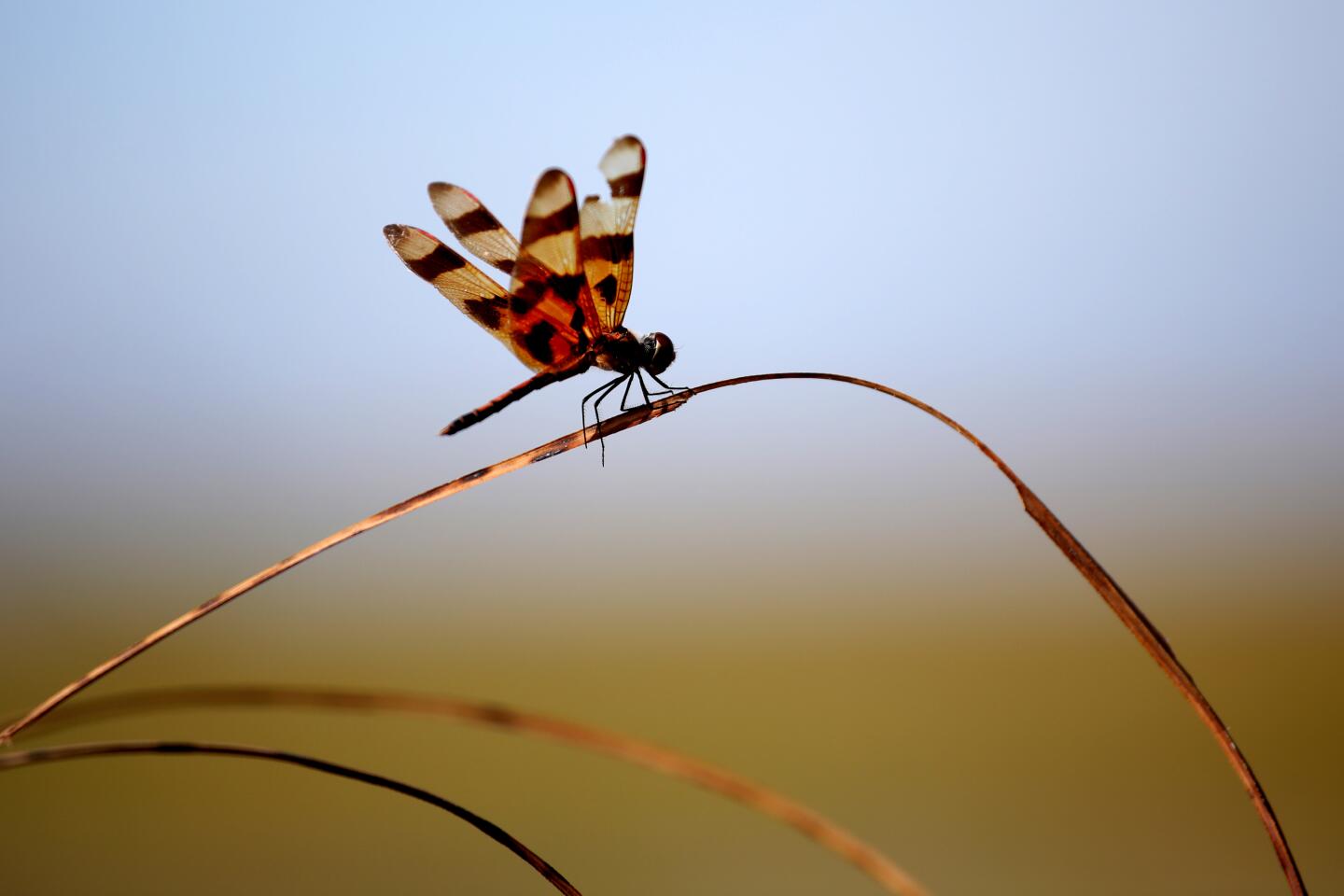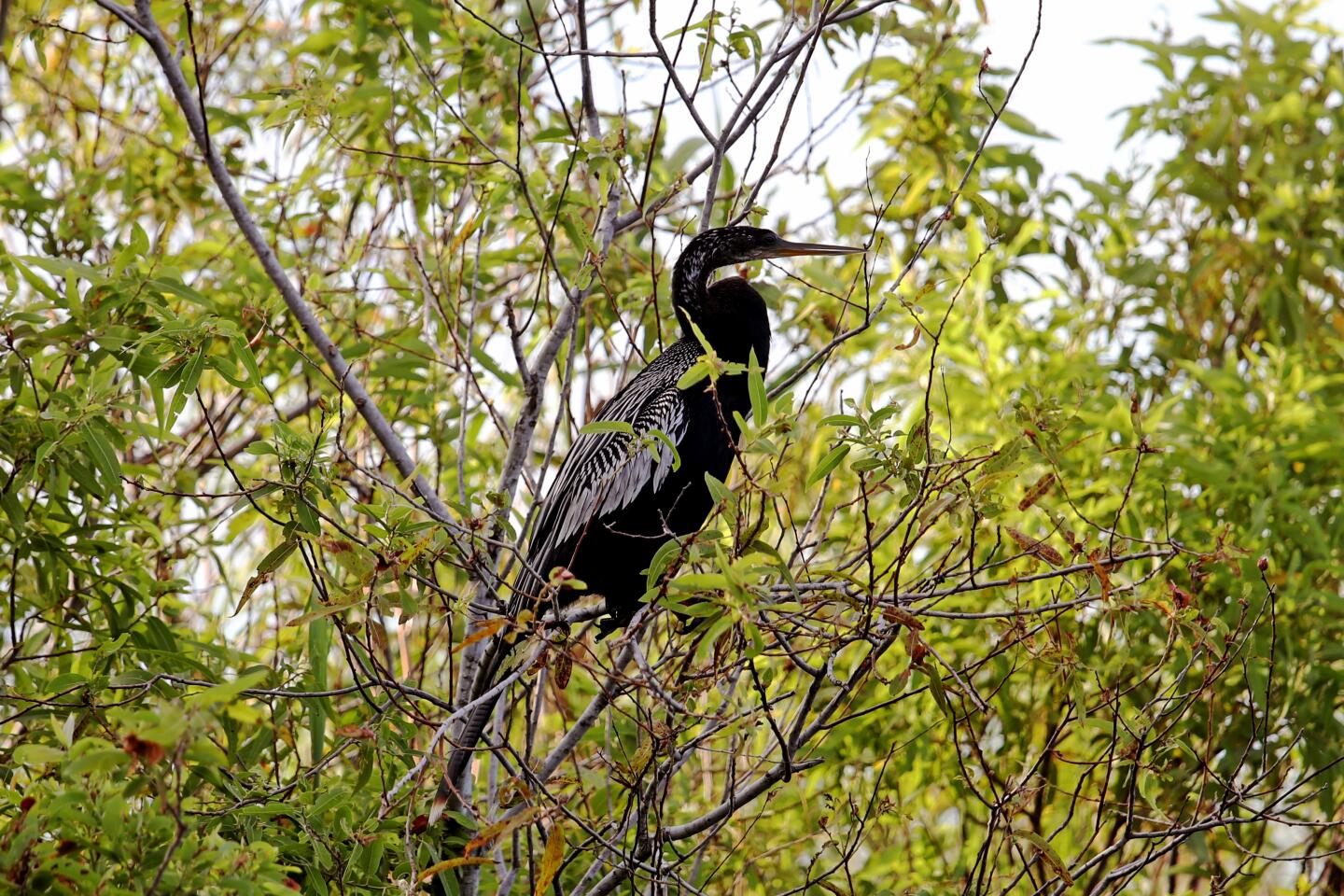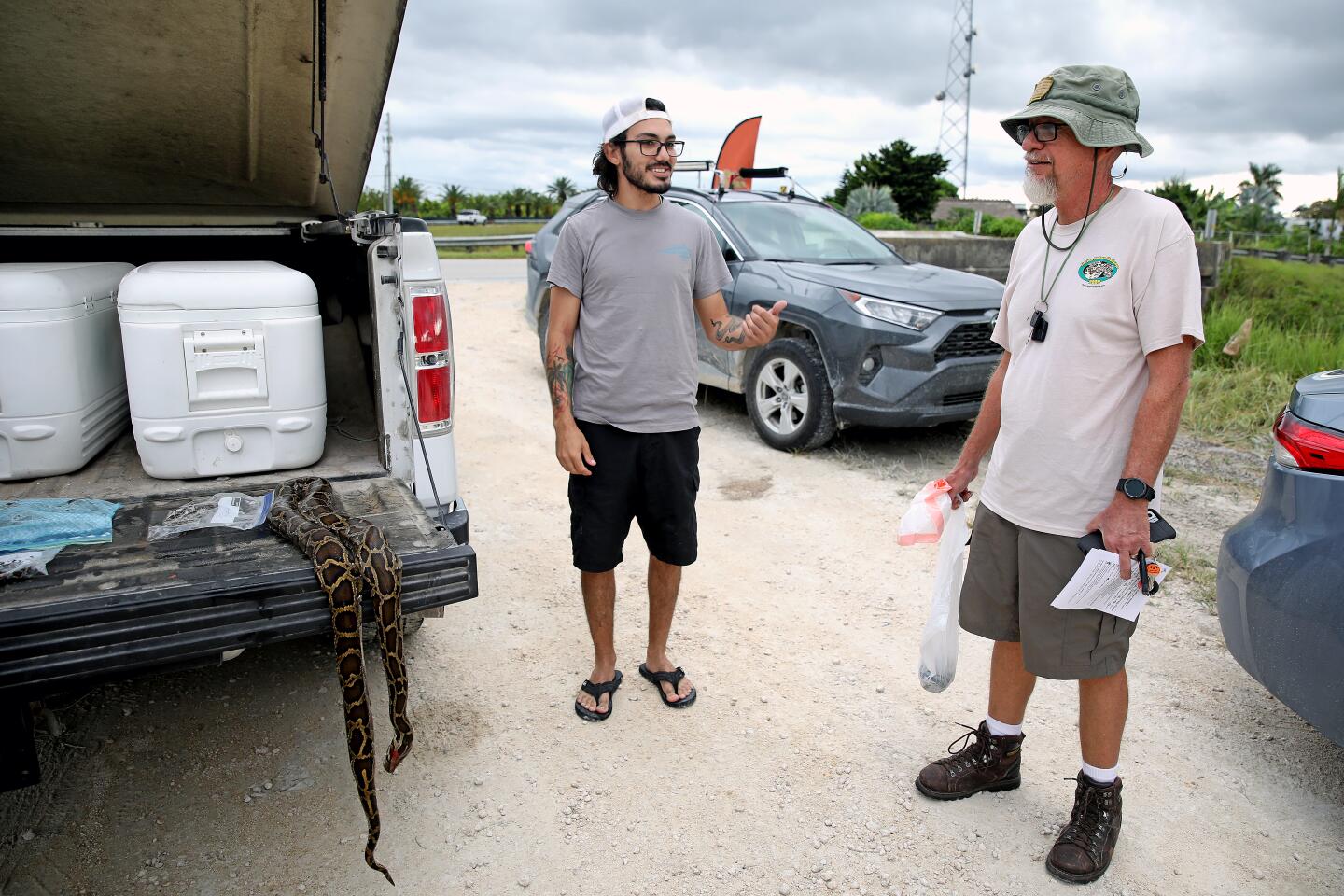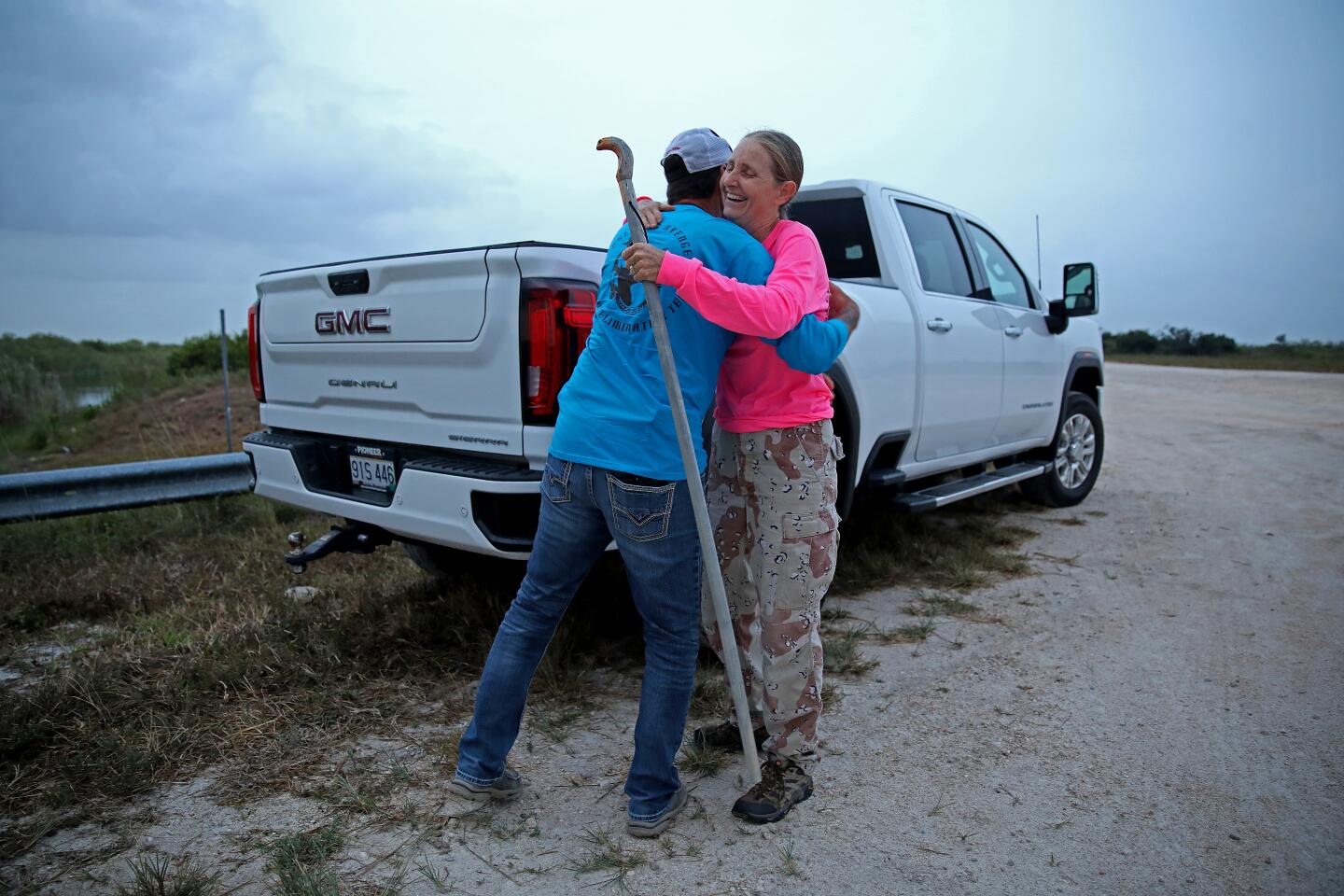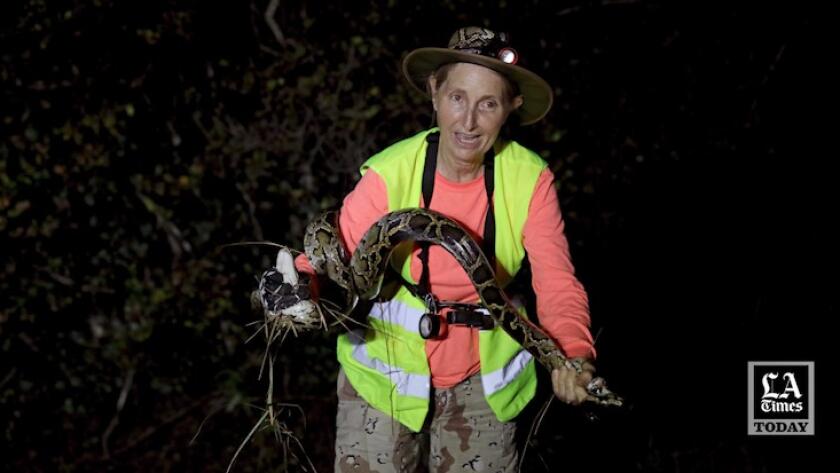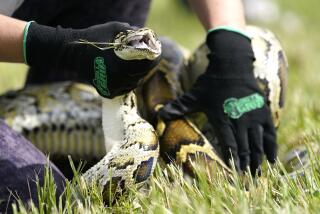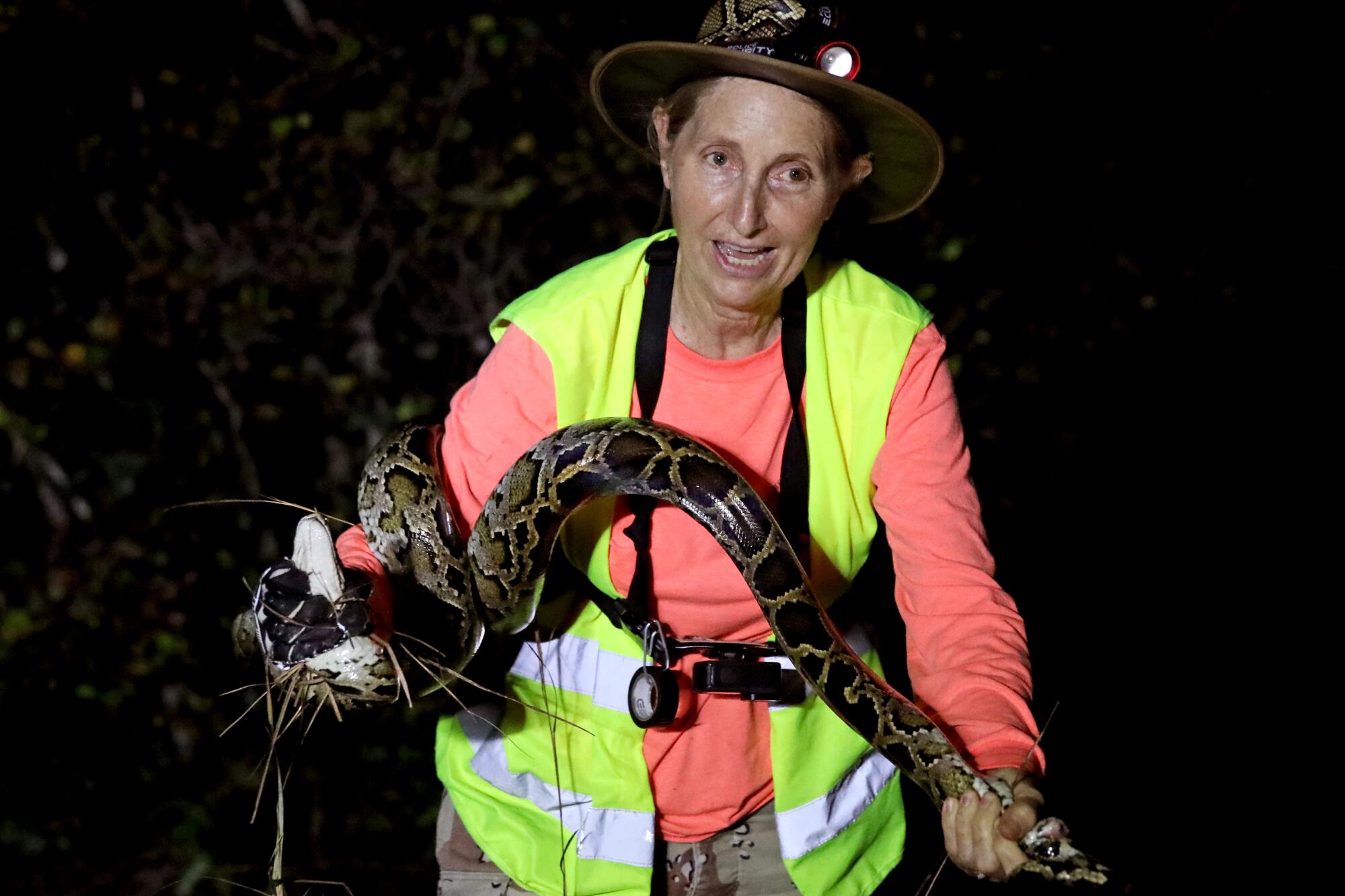
- Share via
KENDALL, Fla. — Donna Kalil loves snakes. She’s been fascinated by them since she was a kid living in the mountains of Venezuela’s capital in the 1960s, where her father was stationed as an Air Force pilot.
“We’d play ‘I spy,’ and we’d use the snakes, birds and other animals that lived in the jungle,” she said. “I developed a really sharp eye.”
Now she kills them.
Not all snakes. Just Burmese pythons. They’ve become a scourge in the Everglades of south Florida since one was first spotted in the 1970s — ferocious, fecund and indiscriminate in their feeding behavior.
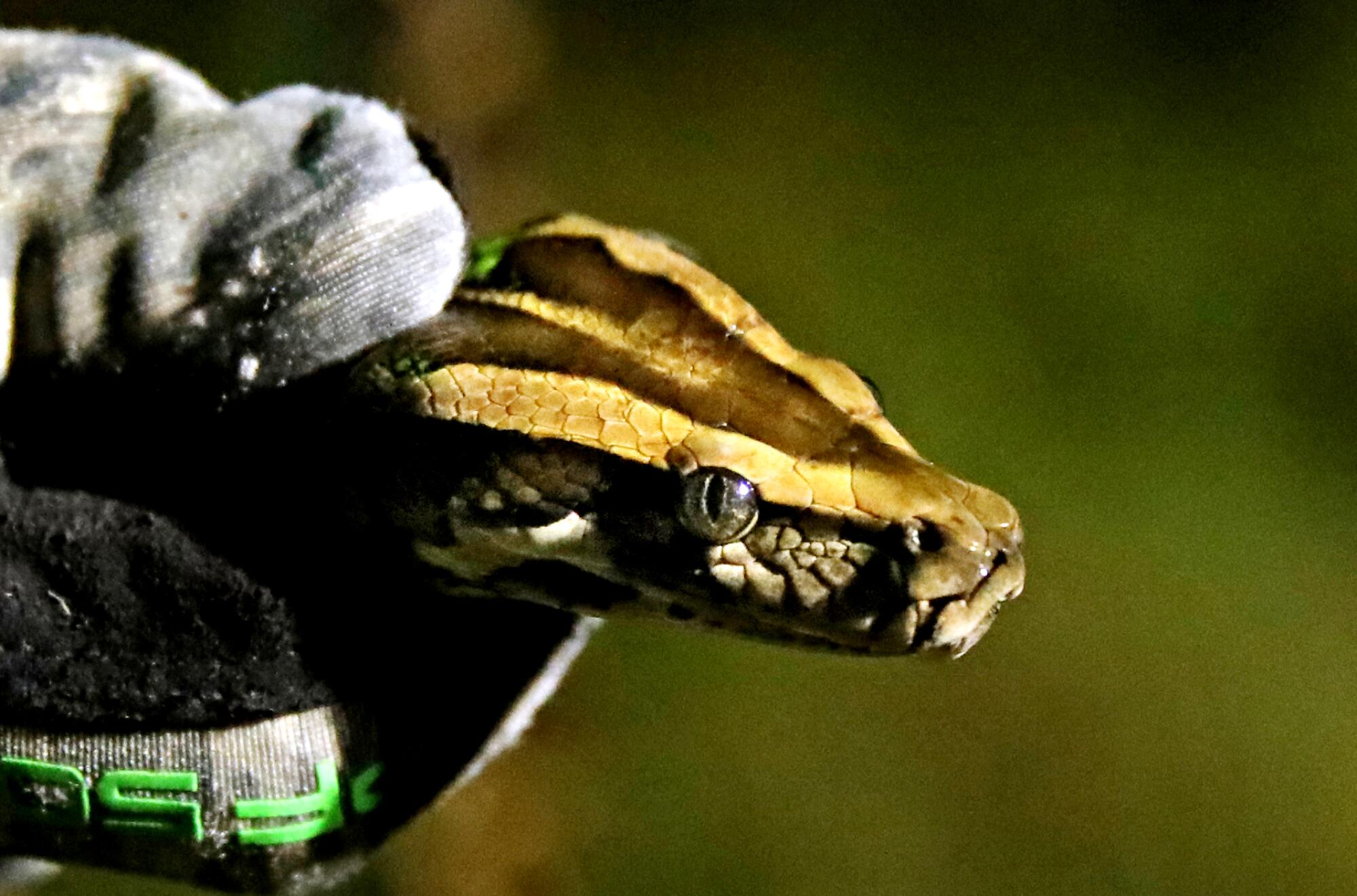
Studies indicate pythons have devastated the Everglades’ mammal population, with some species — such as marsh rabbits and foxes — entirely gone. They also go after amphibians, reptiles and wading birds, including some beloved and endangered species, such as the wood stork.
They’ll even attack and eat the region’s top predators — alligators and crocodiles — when they can stomach them.
In 2005, the National Park Service released a series of photos showing a gator that had busted out of the stomach of a dead 13-foot python. The images went viral and inspired many of the hunters now making a career of culling pythons.
Kalil, 60, is one. Seeing a python eat the region’s apex predator was too much, she said, prompting her to transition from real estate agent to professional serpent killer.
“They were eating everything. They were destroying this beautiful, wonderful place,” she said, referring to the Everglades, the nation’s only subtropical wilderness and one of its most degraded ecosystems.
Over many decades, farmers, engineers and developers ditched and drained much of the 4,000 square miles of the Everglades, with conservation taking hold only after it became a national park in 1947. As suburbs mushroomed nearby, humans introduced an array of exotic species — including Argentine tegus, giant African land snails and green iguanas — into the park’s marshes, hardwood hammocks and other habitats. Now these invasive species threaten to overwhelm efforts to restore the Everglades, with none more voracious than Burmese pythons.
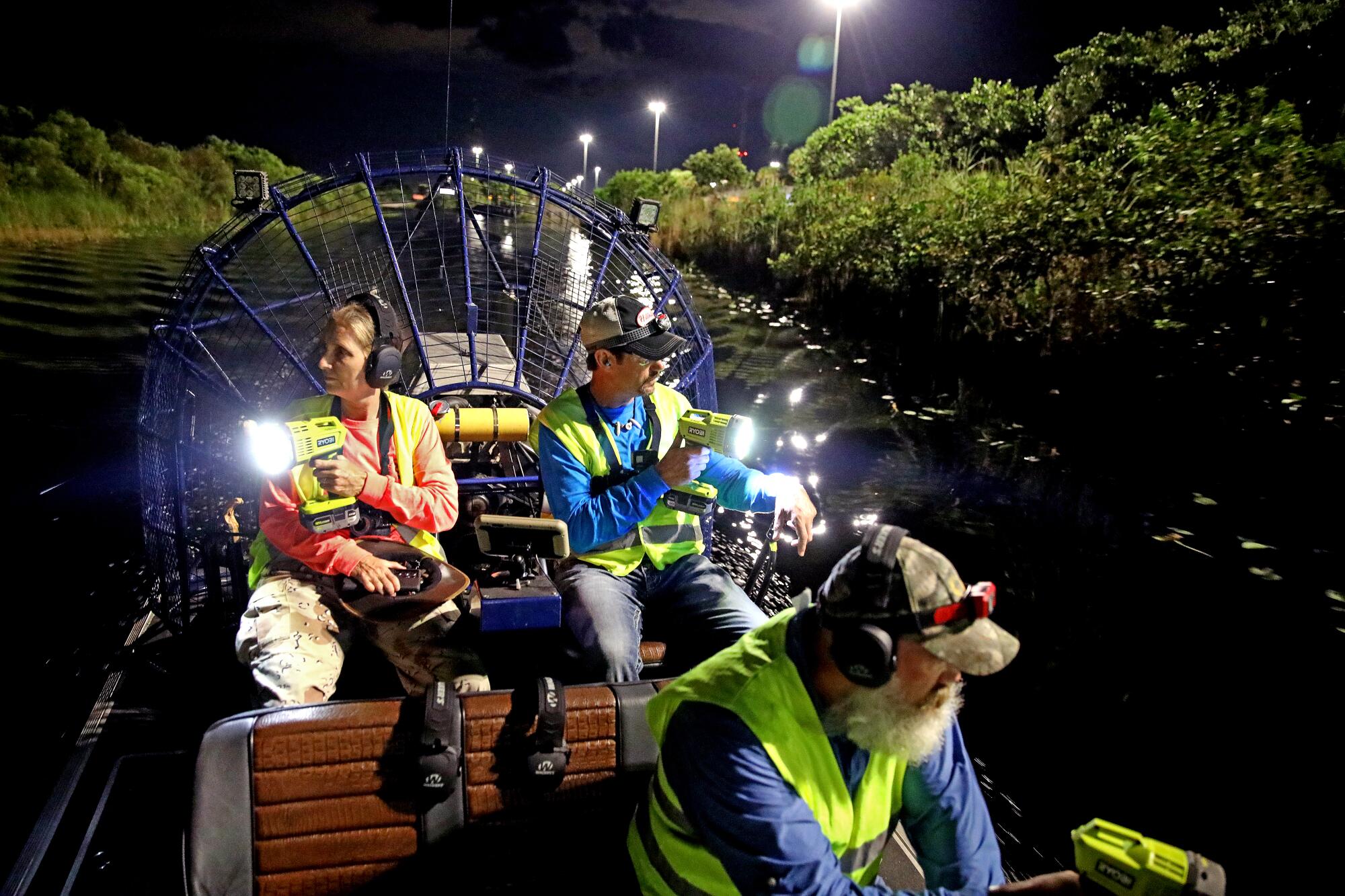
No one knows how many of these giant snakes now infest south Florida, but estimates range from 100,000 to more than a million, said Kevin Donmoyer, an invasive-species biologist at Everglades National Park. Paid contractors and others have killed about 9,000 snakes since 2017, when the hunting program started.
The snakes breed prolifically, laying half a dozen to 100 eggs per nest. And with few natural predators, their numbers show no sign of diminishing.
That’s why, each year, the South Florida Water Management District, the Fish and Wildlife Foundation of Florida and the Florida Fish and Wildlife Conservation Commission sponsor a multi-day python hunting contest, the Florida Python Challenge — open to the public — to see who can bag the largest number of the nonvenomous snakes.
While most Florida python hunters are men, Kalil and one of her proteges, Amy Siewe, have proved to be highly effective eradicators. They hunt not to collect trophies, they say, but to help save the native creatures that live in and around the Everglades.
After assisting Kalil on a few hunts, Siewe left a lucrative real estate business in Indianapolis in 2019 to pursue snakes full time, and now calls herself the Python Huntress.
“I knew I had to drop everything and do this,” she said.
::
As their name implies, Burmese pythons originated in Southeast Asia, where they evolved over the eons to become excellent swimmers and climbers. In their native range, they are considered endangered, kept in check by tigers and king cobras, but now threatened by habitat loss.
Those pressures don’t apply in the Everglades. While their eggs are vulnerable to raccoons and other scavengers, adult Burmese pythons don’t have to worry about becoming prey. And because the Everglades offers such a rich variety of food for the big snakes — the birds and mammals didn’t evolve in an environment with large constrictors — they have a seemingly limitless supply of easy, unsuspecting victims.
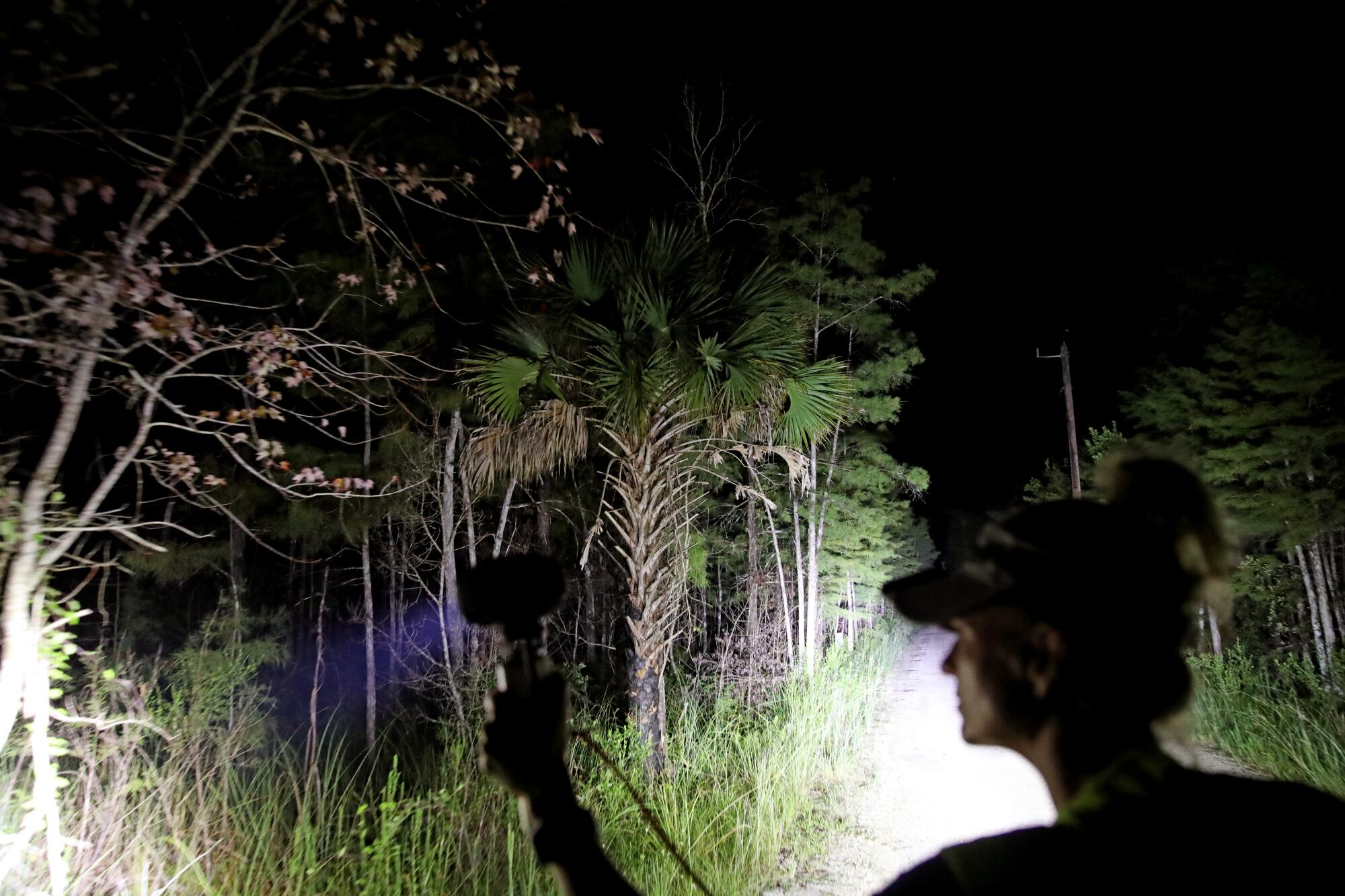
With distinctive brown and black patterning, Burmese pythons have long been coveted both as pets and producers of skins for high-end leather goods. They are commercially farmed in Southeast Asia, and a quick search for python goods at Neiman Marcus showed a $4,200 Bottega Veneta python leather handbag and a $2,750 Saint Laurent purple-dyed python leather shoulder bag.
Most experts believe the exotic pet trade contributed to the Everglades invasion, as pet owners — some not fully prepared to feed and care for a giant python — discarded them into the wild.
Kalil once saw a ball python — a different species — get dumped at the entrance to the park. She took it home, named it Benny and now swims with the 5½-foot python in the lake behind her home.
Genetic analyses indicate the pythons that live in the glades are all closely related. Their DNA primarily aligns with that of Burmese pythons, although there’s also a hint of Indian python, suggesting the two species hybridized at some point in the past.
In south Florida, there’s a well-worn story that Hurricane Andrew in 1992 was a major contributor to the python explosion when the storm blew down a reptile-breeding facility near Homestead, a town south of Miami that sits on the edge of Everglades National Park.
“Not true,” said Walter Meshaka Jr., former supervisory curator of south Florida’s four national parks. “I’m sure it may have added to it. But it certainly wasn’t the only cause. Things have been released, things escape, and there’s been a steady drip of animals for decades.”
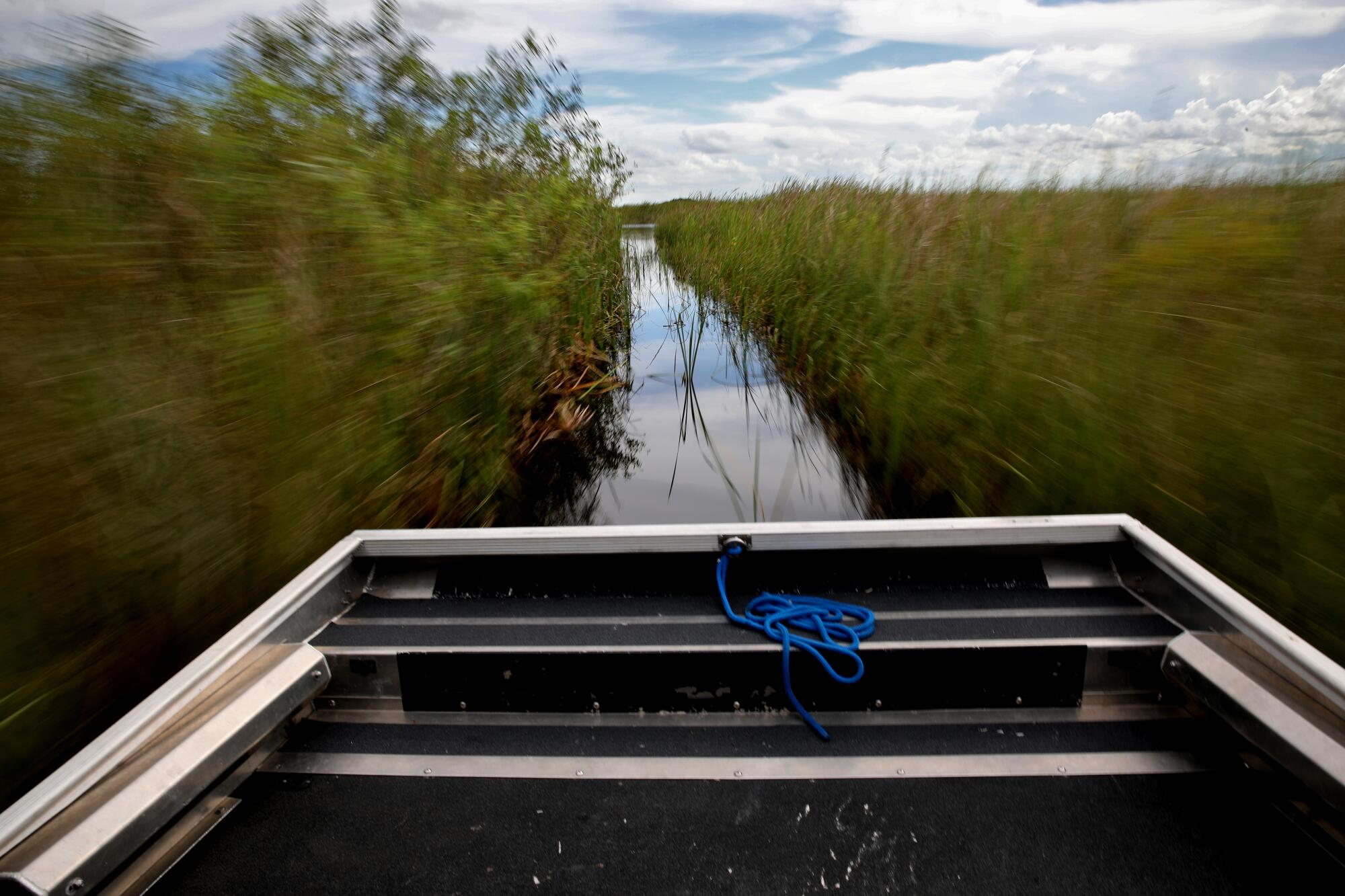
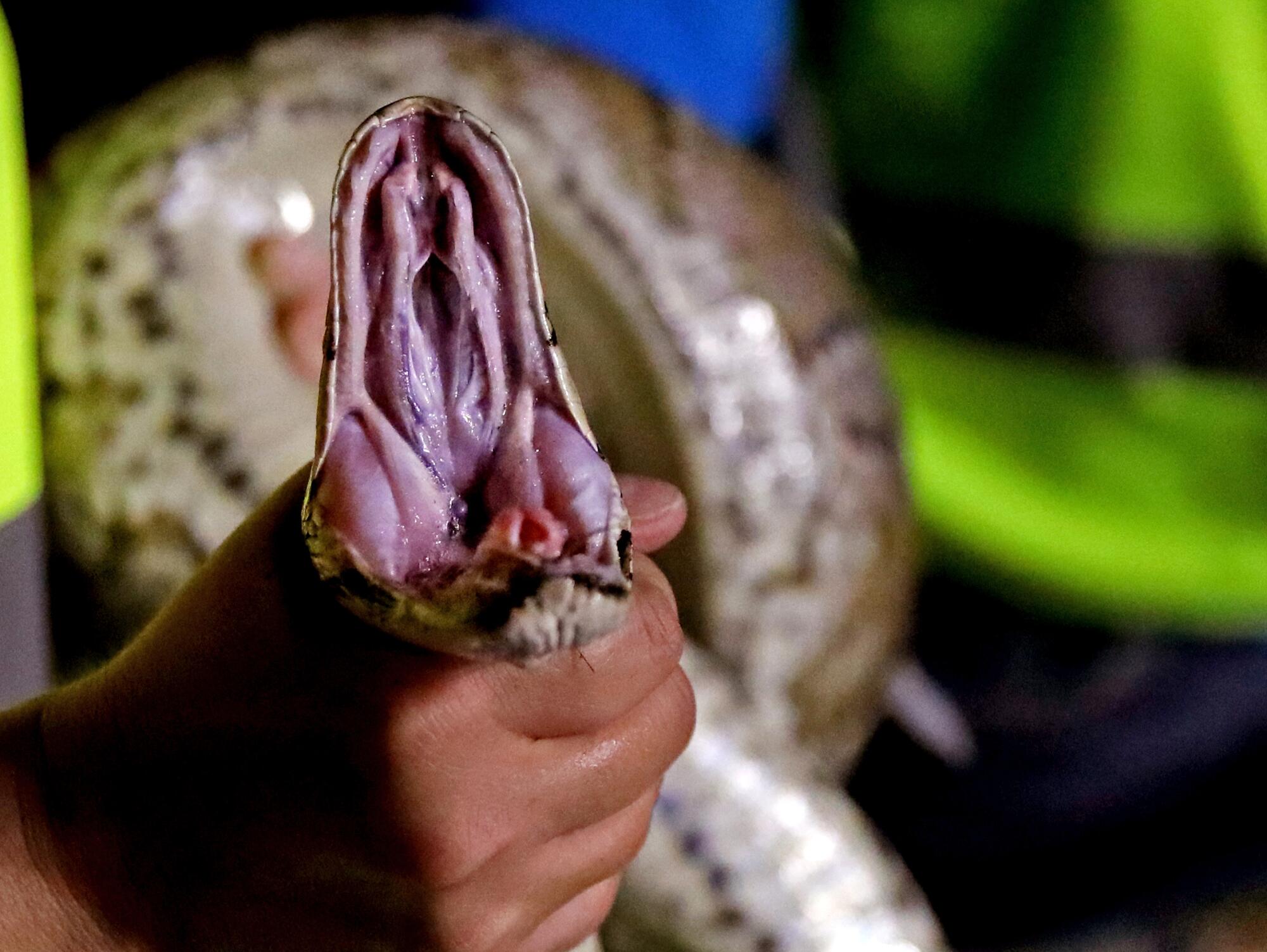
Meshaka, who now works as senior curator of zoology and botany at the State Museum of Pennsylvania, was the first to document an established population of Burmese pythons in the Everglades in 2000, after sporadic sightings in the 1980s and 1990s.
Soon after he left the park system that year, “Burmese pythons just turned up absolutely everywhere. It was as if that last drop of water tipped the vessel over.”
Since that time, the pythons have expanded their range, moving as far north as Lake Okeechobee and south to the Florida Keys — although it’s unclear whether they’ve established a breeding population on the islands.
Modeling the snake’s potential range, researchers say Burmese pythons eventually could establish populations throughout the Southeast and perhaps spread as far north as Virginia and as far west as California.
Whether hunters can significantly reduce the python population remains unclear. So far the only force that has seemingly made a dent in their Florida population is low temperatures.
In 2010, a cold snap in south Florida killed thousands of Burmese pythons. But the region hasn’t seen a sustained cold spell like that since, and experts say climate change is likely to help the predator’s expansion.
“It’s sort of a tragic, comedic story,” said Meshaka, citing the synchronous establishment of the python population and climate change. Cold spells “are getting rare. It just doesn’t get that cold that often anymore.”
::
Python hunters work the night shift — clocking in at sundown and hunting till dawn to track their quarry, which lies low during the sweltering heat of summer days.
As a result, Kalil is often not in bed until 5 or 6 in the morning this time of year. That doesn’t leave much time to spend with her husband — a Miami commercial litigation lawyer — or their two adult kids, an attorney and a systems engineer.
When The Times met up with her in August, she’d been toiling for 19 days straight — work habits that have made her a python-hunting rock star since the water district hired her as a contractor in 2017. As of Sept. 8, she’d caught 694 snakes.
Sporting a long, blond braid and python-skin-brimmed hat, Kalil was one of the first hunters the water district hired, and she claims to have mentored or brought on 27 others. During a recent hunt, Kalil handed out chocolate chip cookies — made with python eggs — to her crew. There were no requests for seconds.
The water district and wildlife commission now pay 100 of these contractors. It is not a road to wealth. Contractors are paid $13 an hour for hunting in most areas; up to $18 per hour where the snakes are rare. They’re also provided cash bonuses for every snake they catch. The bigger the snake, the larger the bounty: $50 for the first four feet and $25 for every additional foot.
Kalil collected $350 for the 16-footer she caught last year. She also won $2,500 for having caught 19 snakes — the highest capture number for a professional hunter — during the 2021 python challenge.
That luck didn’t carry through this year; she caught only six.
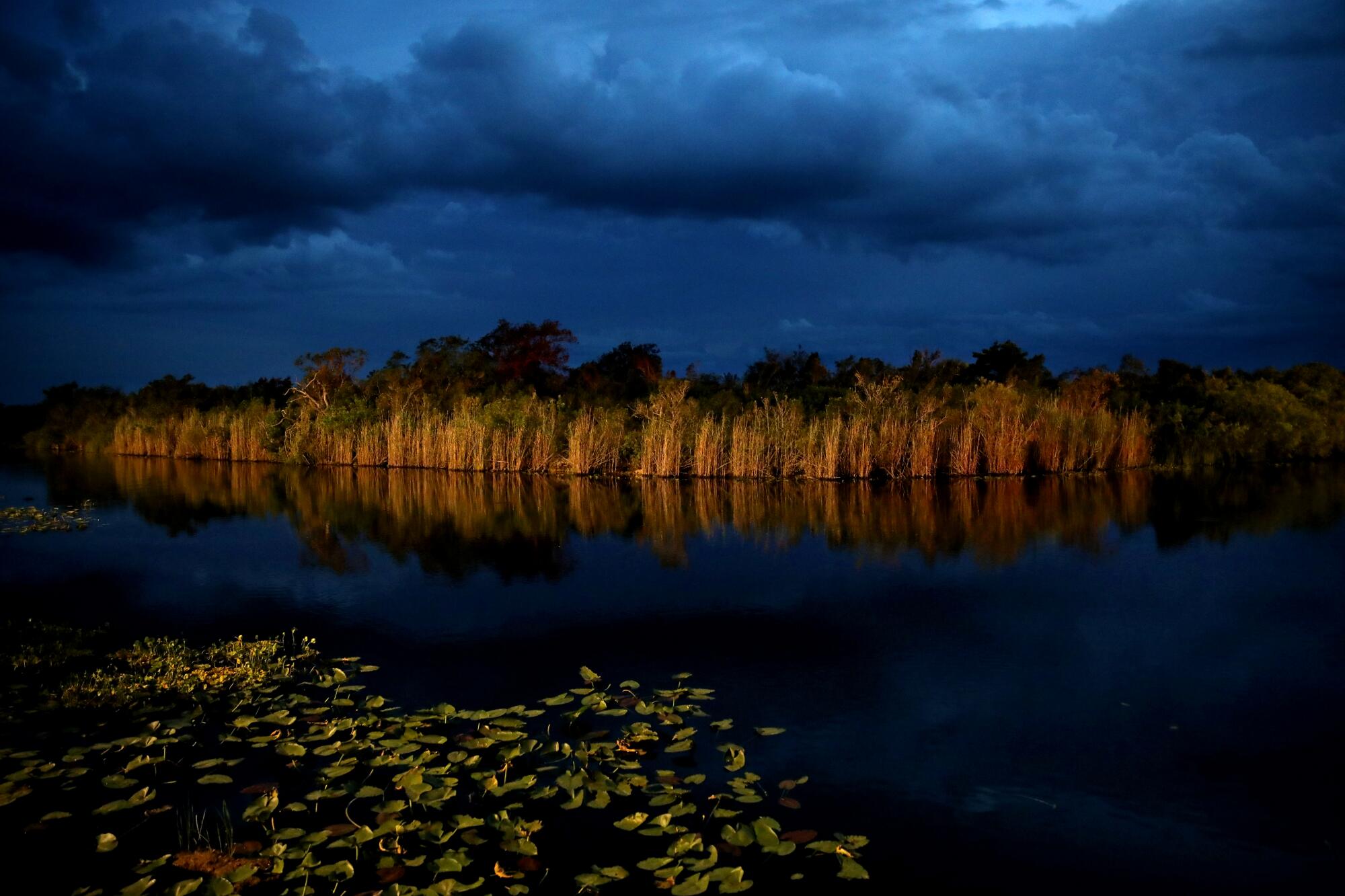
Because hunting is prohibited in Everglades National Park, contractors must prowl for pythons outside the park, navigating a sinuous network of roads and canals. They are given gate-lock keys so they can drive on levees closed to the general public, and are aided in the hunt by trained assistants — many of whom come down to Florida from all over. (The park service occasionally hires contractors to get rid of pythons but does not have a standing program).
“P-p-p-python!!!” yelled Dave Hackathorn, 53, the owner of a tree-trimming and removal business in Waverly, W.Va., on a recent August night. He and Kalil can’t remember how they were introduced, but theirs has proved to be a long-lasting partnership.
Standing atop Kalil’s 1998 Ford Expedition, Hackathorn — who calls himself “Hillbilly Dave” — spotted an 8.5-foot snake slithering in the grass alongside Levee 28, a roughly 17-mile dirt embankment that cuts through the Everglades north of the Tamiami Trail and along the western edge of the Francis S. Taylor Wildlife Management Area.
Kalil, who had been driving at about 20 mph, screeched to a stop, and Hackathorn and two other observers standing atop the retrofitted SUV rocketed back and forth — prevented from falling off by welded-on guardrails adorned with high-wattage floodlights. After regaining their balance, the three observers swiftly descended a ladder in the stern and jogged over to a lackadaisical python slowly slithering up the edge of the levee.
Kalil got to the snake before the roof riders and moved quickly behind it. She deftly distracted the snake by waving one hand around frantically in front of its face. Slowly and steadily, she reached her other hand behind its head. With a deft swoop, she grabbed it around the neck and held it out, away from her body.
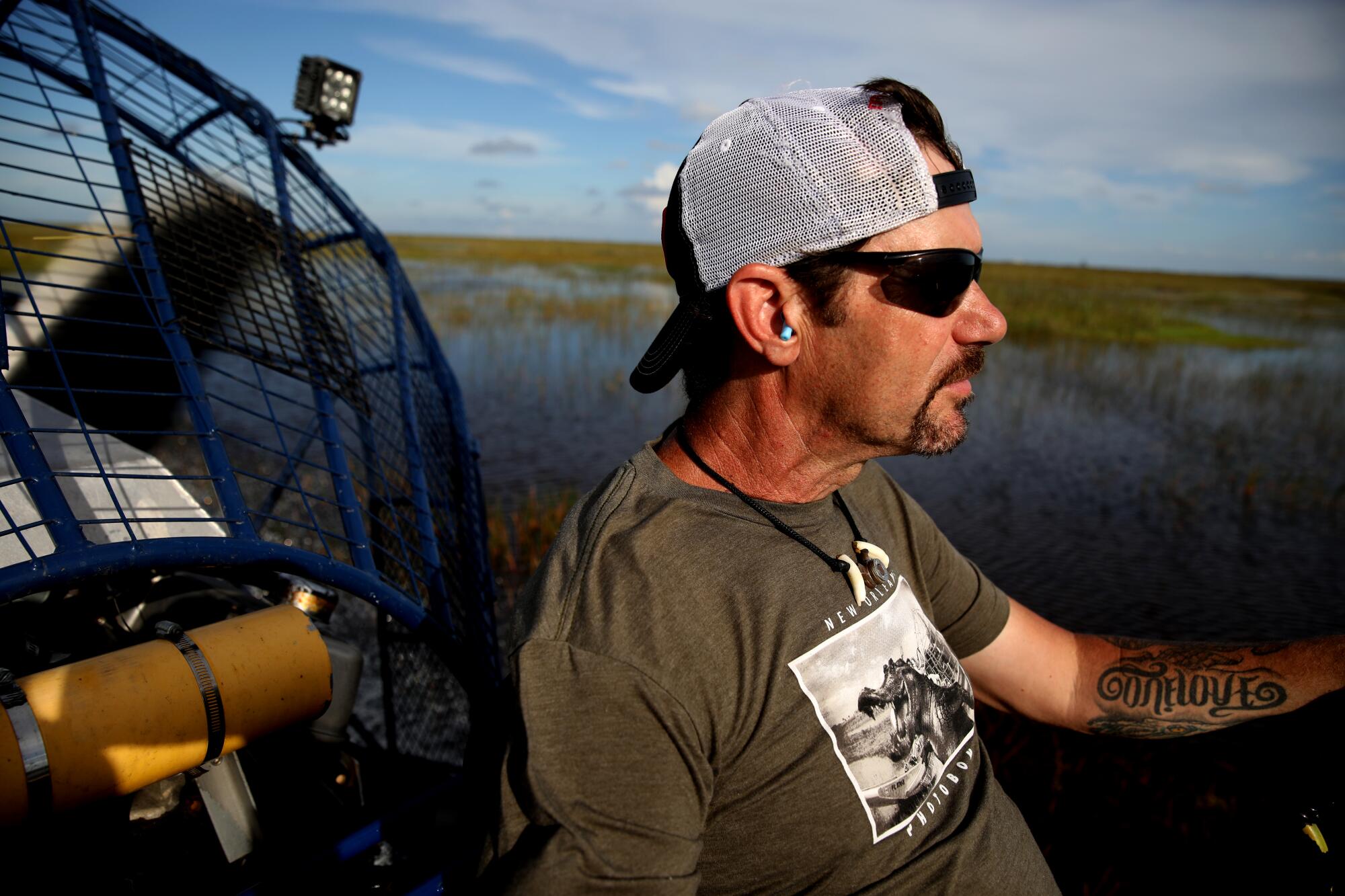
Initially stunned, the python quickly regrouped and began coiling and constricting its long body around Kalil’s right arm, occasionally letting out an angry hiss.
Hackathorn and Jayna Corns, another professional hunter — and one of Kalil’s former mentees — unwrapped the serpent from Kalil’s arm. Stretching it out among the three of them, they posed for a series of smiling selfies. Kalil then handed it off to Hackathorn, who took sole possession and dropped it in a bag — pulling his hand back rapidly as he let go, lest the snake strike and lodge a tooth in his hand.
He’d been bit the night before in just this scenario, fortunately without shrapnel left behind.
There are no known reports of a wild python killing anyone in Florida, but there have been close calls. Kalil remembers catching a smallish 5-foot python in knee-deep water. As she grabbed the snake and held it with both hands, the cellphone in her pocket rang. She let go of the serpent with one hand, using it to retrieve her beckoning phone.
The snake took advantage; it slithered its tail backward up her shoulder and around her neck. And then squeezed.
Kalil, who is a free diver, said she initially wasn’t too worried; she’s an expert at holding her breath for long periods of time. But she quickly realized the snake was constricting the blood supply to her brain — not her breath. She started feeling faint and realized she was in a bad situation.
Fortunately, Kalil had assistants with her, and they managed to untether the reptile from her neck. She never dropped her phone.

::
Some states draw tourists by hosting waterfowl festivals. Florida does the same with a python bounty. Held each year, the Florida Python Challenge attracts hundreds of contestants, some lured by the marketing pitch on the contest’s website: “Chance to Win Ultimate $10,000 Grand Prize!”
The contest is divided into professional and amateur categories, with all participants having to pay $25 and watch a short video on how to kill a snake humanely. The first step is to use blunt force trauma between the eyes to stun the animal. Then the contestants must pith all brain tissue from the skull — to ensure the python is dead.
Contestants are required to turn in their quarry at checkpoints, where contest officials collect the snakes and make sure they were killed properly.
At one such drop-off, Ronnie Rodriguez rolled up in his truck, carrying a python he’d caught the night before. But the animal hadn’t been left on ice overnight and was starting to smell, piquing Mike Kirkland, the water district’s python program manager.
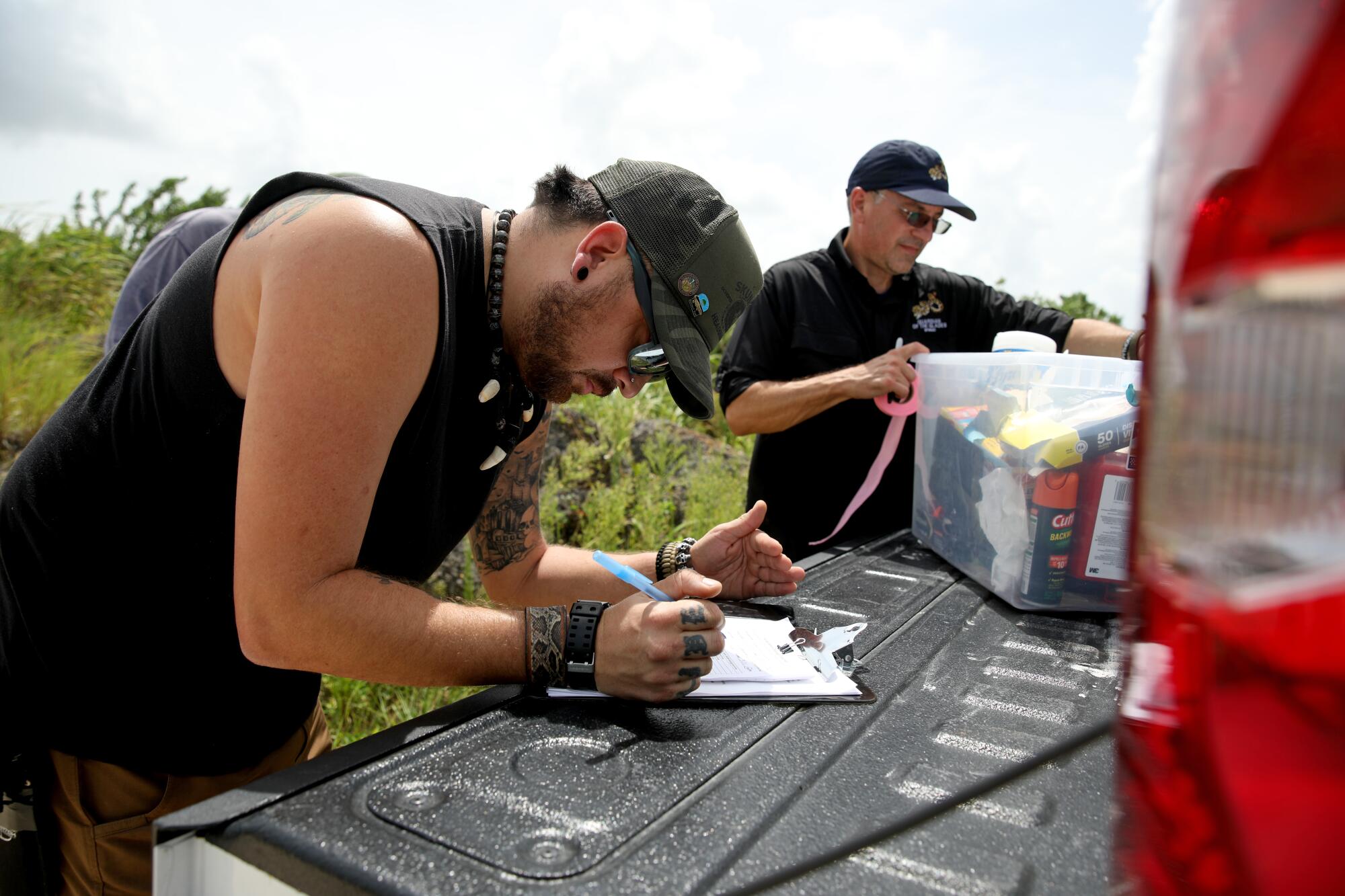
“I’ll take it, but it might get disqualified,” said Kirkland after noticing that Rodriguez hadn’t dispatched the snake as required.
All too often, a night of hunting ends with no pythons in the bag. After two unsuccessful nights of patrolling levee roads, Kalil and her crew expanded their search to the open water, in Hackathorn’s airboat.
Kalil looked for islands with palmettos. The crew would glide up to an island’s edge, disembark and hack its way through thick shrubs, bushes and trees, shining flashlights on the root-laden ground.
Mosquitoes swarmed while mouse-size dragonflies bombarded the hunters with thwacking, thumping thuds.
Kalil and assistants returned to the boat draped in spiderwebs but carrying no pythons.
::


Siewe, the self-proclaimed Python Huntress, is similarly drawn to the forbidding swamp-scapes of south Florida. In her case, she hunts in the hopes of supplementing her income with skins of the snakes she bags.
In her condominium just east of Naples, a wheeled garment rack at the end of her bed is loaded with a rainbow of at least 50 dyed and tanned python skins. She sells the skins to high-end watch band, belt and bracelet makers. She’s worked for three years to perfect her skinning process and now works with a tanner who treats the skins to her liking.
“They’re pretty fragile,” she said of the skins. “They’re really only good for small, more ornamental items.”
On a recent afternoon, she invited a Times team to watch her skin two pythons on her back deck. Practiced and efficient, she filleted and skinned the snakes in a matter of minutes.

Siewe — blond, tan, lithe and a former homecoming queen from the Dayton, Ohio, area — has caught more than 400 pythons (she can’t remember the exact count), including a 17-footer that weighed 110 pounds. Before moving to Florida, she claimed some internet fame after her fiance posted a video of her catching dozens of water snakes — by hand — from Lake Erie.
Like Kalil, Siewe loves these snakes and she doesn’t relish killing them. She’s made it a profession to help protect native wildlife.
It’s why she won’t let the skins go to waste, she said. Keeping them honors the lives of these apex predators.
“They didn’t ask to be here,” she said. “It’s not their fault.”
- Share via
Watch L.A. Times Today at 7 p.m. on Spectrum News 1 on Channel 1 or live stream on the Spectrum News App. Palos Verdes Peninsula and Orange County viewers can watch on Cox Systems on channel 99.
More to Read
Sign up for Essential California
The most important California stories and recommendations in your inbox every morning.
You may occasionally receive promotional content from the Los Angeles Times.
